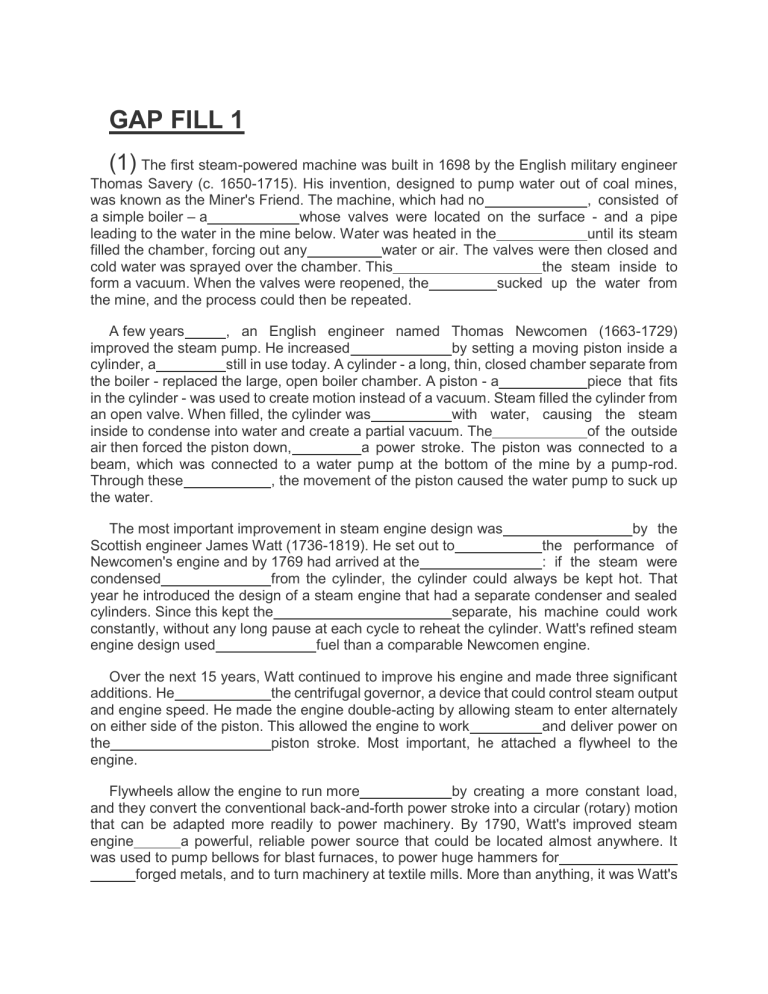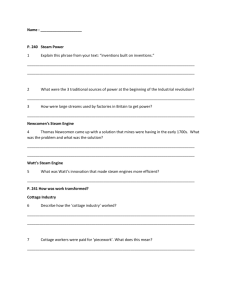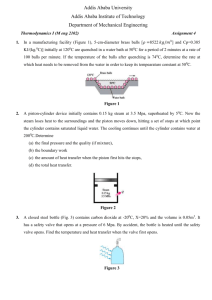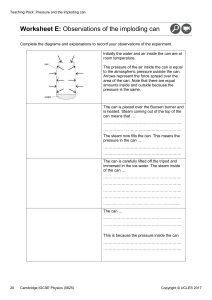
GAP FILL 1 (1) The first steam-powered machine was built in 1698 by the English military engineer Thomas Savery (c. 1650-1715). His invention, designed to pump water out of coal mines, was known as the Miner's Friend. The machine, which had no , consisted of a simple boiler – a whose valves were located on the surface - and a pipe leading to the water in the mine below. Water was heated in the until its steam filled the chamber, forcing out any water or air. The valves were then closed and cold water was sprayed over the chamber. This the steam inside to form a vacuum. When the valves were reopened, the sucked up the water from the mine, and the process could then be repeated. A few years , an English engineer named Thomas Newcomen (1663-1729) improved the steam pump. He increased by setting a moving piston inside a cylinder, a still in use today. A cylinder - a long, thin, closed chamber separate from the boiler - replaced the large, open boiler chamber. A piston - a piece that fits in the cylinder - was used to create motion instead of a vacuum. Steam filled the cylinder from an open valve. When filled, the cylinder was with water, causing the steam inside to condense into water and create a partial vacuum. The of the outside air then forced the piston down, a power stroke. The piston was connected to a beam, which was connected to a water pump at the bottom of the mine by a pump-rod. Through these , the movement of the piston caused the water pump to suck up the water. The most important improvement in steam engine design was by the Scottish engineer James Watt (1736-1819). He set out to the performance of Newcomen's engine and by 1769 had arrived at the : if the steam were condensed from the cylinder, the cylinder could always be kept hot. That year he introduced the design of a steam engine that had a separate condenser and sealed cylinders. Since this kept the separate, his machine could work constantly, without any long pause at each cycle to reheat the cylinder. Watt's refined steam engine design used fuel than a comparable Newcomen engine. Over the next 15 years, Watt continued to improve his engine and made three significant additions. He the centrifugal governor, a device that could control steam output and engine speed. He made the engine double-acting by allowing steam to enter alternately on either side of the piston. This allowed the engine to work and deliver power on the piston stroke. Most important, he attached a flywheel to the engine. Flywheels allow the engine to run more by creating a more constant load, and they convert the conventional back-and-forth power stroke into a circular (rotary) motion that can be adapted more readily to power machinery. By 1790, Watt's improved steam engine a powerful, reliable power source that could be located almost anywhere. It was used to pump bellows for blast furnaces, to power huge hammers for forged metals, and to turn machinery at textile mills. More than anything, it was Watt's steam engine that speeded up the world. both in England and the rest of the Steam was successfully to powerboats in 1802 and railways in 1829. Later, some of the first automobiles were by steam. In the 1880s, the English engineer Charles A. Parsons (1854-1931) produced the first steam turbine, a new steam technology that was more efficient and which enabled the steam engine to evolve into a highly and powerful engine that propelled huge ships and ran that supplied electricity. Once the dominant power source, steam engines eventually as other power sources became available. Although there were more than 60,000 steam cars made in the United States between 1897 and 1927, the steam engine eventually gave way to the as a power source for vehicles. [ moving parts; steam chamber; boiler chamber; pressure; sliding; brought about; separately; adapted; technique; turbogenerators; chilled and condensed; smoothly; efficiency; conclusion; heating and cooling processes; Industrial Revolution; improvement; one-third less; vacuum; remaining; later; shaping and strengthening; sophisticated; internal combustion engine; sliding; declined in popularity; connections; downward and upward; powered; sprayed; producing; separately; introduced; adapted; offered; rapidly ] (2) Every autumn, when of new graduates and begins, major cities in Japan are flooded with students hunting for a job. Wearing suits for the first time, they run from one interview to another. The season is crucial for many students, as their whole lives may be during this period. In Japan, is commonly practised by large companies. While people working in small companies and those working for sub-contractors do not in general enjoy the advantages by the large companies, there is a general expectation that employees will in fact remain more or less permanently in the same job. Unlike in many Western countries where companies employ people whose skills can be effective , Japanese companies select with potential who can be trained to become suitable . For this reason, recruiting employees is an important for companies, as they invest a lot of time and money in training new staff. This is basically true both for and for . Professionals who have studied subjects which are of immediate use in the workplace, such as industrial engineers, are very often in factories and transferred from one section to another. By gaining experience in several different areas and by in close contact with workers, the engineers are believed, , to become more effective members of the company. Workers too feel more involved by with professionals and by being allowed to voice their opinions. Loyalty is believed to be cultivated in this type of working environment. Because of this system of training employees to be , mobility between companies is low. Wages are set according to or initial field of employment, ordinary graduates being employed in administration, in engineering and design and so on. Both promotions and wage increases tend to be tied to , though some differences may arise later on as a result of ability and business performance. Wages are paid monthly, and the net sum, after the of tax, is usually paid into a bank account. As well as salary, a bonus is usually twice a year. This is a custom that to the time when employers gave special so that employees could properly celebrate bon, a Buddhist festival held in mid-July in Tokyo, but on other dates in other regions. The festival is held to appease the souls of ancestors. The second bonus is at New Year. Recently, bonuses have also been offered as a way of allowing workers a share in the profits that their hard work has gained. Many female graduates complain that they are not given equal training and equal opportunity in to male graduates. Japanese companies generally believe that female employees will leave to get married and have children. It is also true that, as well as the still-existing belief women themselves that nothing should of child-rearing, the extended hours of work often do not allow women to continue their careers after marriage. Disappointed female graduates often to work for foreign firms. Since most male graduates prefer to join Japanese with their guaranteed security, foreign firms are often to employ female graduates as their potential tends to be greater than that of male applicants. Some men, however, do leave their companies future prospects, one reason being to the family business. The eldest sons in families that own family companies or businesses such as stores are normally expected to take over the business when their parents . It is therefore quite common to see a businessman, on to his parents' business, change his professional direction by becoming, for example, a shopkeeper. On the job, tend to be very close because of the long hours of work and years of service in common. Social life in fact is based on the workplace. Restaurants and nomi-ya, "pubs", are always crowded at night with people enjoying an evening out with their . Many companies organise trips and sports days for their employees. Senior staff often play the role of . This may mean becoming involved in the lives of junior staff in such things as marriage and the children's education. The age of retirement is between 55 and 60. For most Westerners, retirement may be an eagerly time to undertake such things as travel and hobbies. Many Japanese, however, simply cannot get used to the freedom of retirement and they look for ways of using their time. Many look for new jobs, feeling that if they do not work they will be by society. This has recently to the development in some municipalities of municipal job centres which advertise casual work such as cleaning and lawn mowing. Given that Japan is facing the problem of an ageing society, such activities may be vital in the future. [ stand in the way; in spite of; working relationships; constructively; recruitment; lifetime employment; applicants; egalitarian; deduction; colleagues; average; increasingly; succeeding; factory workers; professionals; school leavers; paid; completely; educational background; departments; career-minded; comparison; dates back; conferred; determined; frequently; mentor; abandoned; awaited; immediately; employees; in the long run; all-rounders; opt; allowances; distributed; engineers; eventually; firms; take over; placed; working; exercise; keen; seniority; directly; among; retire; led ] (3) The idea that scientific knowledge is dangerous is deeply in our culture. Adam and Eve were to eat from the Tree of Knowledge, and in Milton's Paradise Lost the serpent the tree as the 'Mother of Science'. Indeed the whole of western literature has not been kind to scientists and is filled with images of them with nature with disastrous results. Just consider Shelley's Frankenstein, Goethe's Faust and Huxley's Brave New World. One will search with very little success for a novel in which scientists well - the persistent image is that of scientists as a soulless group unconcerned with issues. And where is there a film sympathetic to science? Part of the problem is the of science and technology. The distinction between science and technology, between knowledge and understanding on the one hand and the application of that knowledge to making something, or using it in some practical way, is . Science ideas about how the world works, whereas the ideas in technology result in objects. Technology is much older than anything one could regard as science and by any science. Technology gave rise to the crafts of early humans, like agriculture and . It is technology that carries with it ethical issues, from motorcar production to cloning a human. By contrast, reliable scientific knowledge is value-free and has no moral or ethical value. Science tells us how the world is. That we are not at the of the universe is neither good nor bad, nor is the possibility that genes can influence our intelligence or our . The social obligations that scientists have as from those responsibilities they share with all citizens comes from them having access to specialised knowledge of how the world works, not easily to others. Their obligation is to both make public any social implications of their work and its possible applications and to give some of its reliability. It is not easy to find examples of scientists as a group behaving immorally or in a dangerous , the classic paradigm being the eugenics movement. The scientific assumptions behind this are crucial; the assumption is that most desirable and undesirable human are inherited. Not only was talent perceived of as being inherited, but so too were insanity and any kind of so-called feeblemindedness. They completely failed to give an assessment of the of their ideas. Quite the contrary, and even more blameworthy, their conclusions seem to have been driven by what they saw as the desirable social implications. By contrast, in to the building of the atomic bomb, scientists behaved and fulfilled their social obligations by informing their governments about the of atomic theory. It was an enormous engineering to build the bomb but the decision to do this was taken by politicians, not scientists. The moralists have been out in force telling us of the horrors of cloning. Many others, national leaders included, have a chorus of horror. But what horrors? What ethical issues? In all the righteous indignation not a single relevant new ethical issue has been spelled out. Those who propose to clone a human are technologists not scientists. It is not, as the bio-moralists claim, that scientific innovation has outstripped our social and moral . Just the opposite is the case. Their obsession with the life of the embryo has deflected our attention away from the real issue, which is how children are raised and nurtured. The ills in our society have nothing to do with assisting or preventing reproduction but are profoundly affected by how children are treated. So what does genetics pose? Gene therapy, introducing genes to cure a genetic disease like cystic fibrosis, carries risks, as do all new medical treatments. There may well be problems with the testing of new , but are these difficulties any different from those related to trying out new drugs for AIDS? Anxieties about creating designer babies are at present premature as it is too risky, and we may have, in the first instance, to accept what has been called procreative autonomy, a couple's right to control their own role in unless the state has a compelling reason for denying them that control. Should the ethical issues relating to the applications of genetics, for example, lead to stopping research in this ? The individual scientist cannot decide, for science, like genetics, is a collective activity with no single individual controlling the process of discovery. It is ethically unacceptable and impractical to censor any aspect of trying to understand the nature of our world. [ usable; assessment; reliability; joined in; treatments; metalworking; centre; meddling; conflation; fundamental; proposal; implications; embedded; distinct; behavior; accessible; attributes; reproduction; field; forbidden; ethical; manner; relation; morally; medical; addresses; produces; come out; unaided; merely; danger; feat ]






